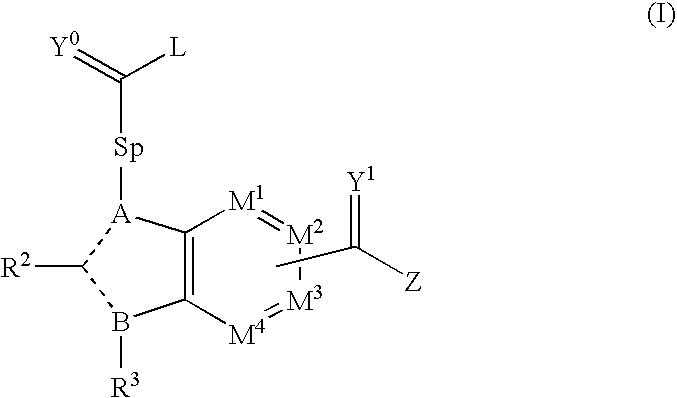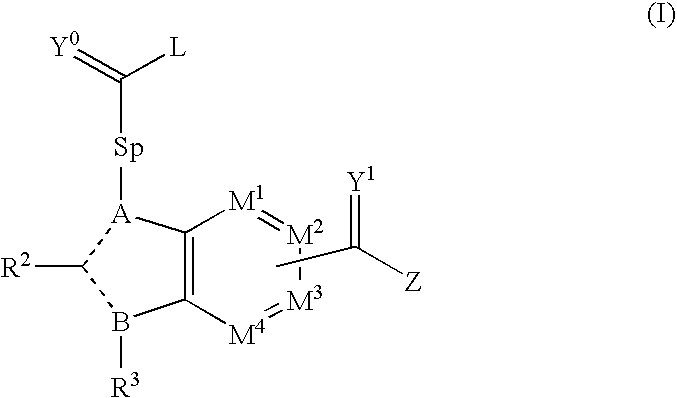Viral Polymerase Inhibitors
a polymerase inhibitor and polymerase technology, applied in the field of hcv polymerase inhibitors, can solve the problems of no vaccine to prevent hcv infection, and achieve the effects of inhibiting rna synthesis, low to very low or even non-significant activity, and good to very good inhibitory activity
- Summary
- Abstract
- Description
- Claims
- Application Information
AI Technical Summary
Benefits of technology
Problems solved by technology
Method used
Image
Examples
example 1
3-Cyclohexyl-2-phenylindole-6-carboxylic acid
[0835]
Methyl 3-amino-4-iodobenzoate
[0836] 3-Amino-4-iodobenzoic acid (13.35 g, 50.8 mmol) was added to MeOH (150 mL) and SOCl2 (4.8 mL, 65.8 mmol, 1.3 equivalent) was added. The mixture was refluxed for 3 h and then volatiles were removed under reduced pressure. The residue was co-evaporated 3× with MeOH and dried in vacuo (15.23 g).
Methyl 3-trifluoroacetamido-4-iodobenzoate
[0837] The aniline derivative from above (14.53 g, 52 mmol) was dissolved in DCM (200 mL) and TFAA (15 mL, 104 mmol) was added. The dark purple solution was refluxed overnight. Volatiles were removed under reduced pressure and the residue was passed through a short pad of silica gel using DCM as eluent. The desired product was obtained as a pink solid (13.81 g): MS (ES−) m / z 371.9 (M-H).
4-Phenylethynyl-3-(2,2,2-trifluoro-ethanoylamino)-benzoic acid methyl ester
[0838] The iodide from above (0.742 g, 2 mmol), phenylacetylene (0.37 mL, 3.9 mmol, 1.7 equivalent) and ...
example 2
Methyl 2-bromo-3-cyclohexyl-6-indole carboxylate t,1010
3-Cyclohexenyl-6-indole carboxylic acid
[0843] A 12 L round-bottomed flask was equipped with a reflux condenser and a mechanical stirrer, and the system was purged with nitrogen gas. 6-indole carboxylic acid (300.00 g, 1.86 mole, 3 equivalents) was charged into the flask, followed by MeOH (5.5 L). After stirring for 10 min at room temperature, cyclohexanone (579 mL, 5.58 mole) was added. Methanolic sodium methoxide (25% w / w, 2.6 L, 11.37 mole, 6.1 equivalents) was added in portions over 10 min. The mixture was then refluxed for 48 h. After cooling to room temperature, water (4 L) was added and methanol removed under reduced pressure. The residual aqueous phase was acidified to pH 1 with concentrated HCl (˜1.2 L). The resulting yellowish precipitate was collected by filtration, washed with water and dried under vacuum at 50° C. The desired cyclohexene derivative was obtained as a beige solid (451.0 g, 100% yield).
3-Cyclohexyl-6-...
example 3
Methyl 2-bromo-3-cyclopentyl-6-indole carboxylate
[0848]
3-Cyclopentenyl-6-indole carboxylic acid
[0849] A 3 L three-necked flask equipped with a mechanical stirrer was charged with indole 6-carboxylic acid (220 g, 1.365 mole) and KOH pellets (764.45 g, 13.65 mole, 10 equivalents). Water (660 mL) and MeOH (660 mL) were added and the mixture heated to 75° C. Cyclopentanone (603.7 mL, 6.825 mole, 5 equivalents) was added dropwise over 18 h using a pump. The reaction mixture was heated for an additional 3 h (after which the reaction was judged complete by HPLC) and cooled to 0° C. for 1 h. The precipitated potassium salt is collected by filtration, and washed with TBME (2×500 mL) to remove cyclopentanone self-condensation products. The brown solid was re-dissolved in water (2.5 L) and the solution washed with TBME (2×1 L). Following acidification to pH 3 with conc. HCl (425 mL), the beige precipitate was collected by filtration, washed with water (2×1 L) and dried under vacuum at 70° C....
PUM
 Login to View More
Login to View More Abstract
Description
Claims
Application Information
 Login to View More
Login to View More - R&D
- Intellectual Property
- Life Sciences
- Materials
- Tech Scout
- Unparalleled Data Quality
- Higher Quality Content
- 60% Fewer Hallucinations
Browse by: Latest US Patents, China's latest patents, Technical Efficacy Thesaurus, Application Domain, Technology Topic, Popular Technical Reports.
© 2025 PatSnap. All rights reserved.Legal|Privacy policy|Modern Slavery Act Transparency Statement|Sitemap|About US| Contact US: help@patsnap.com



